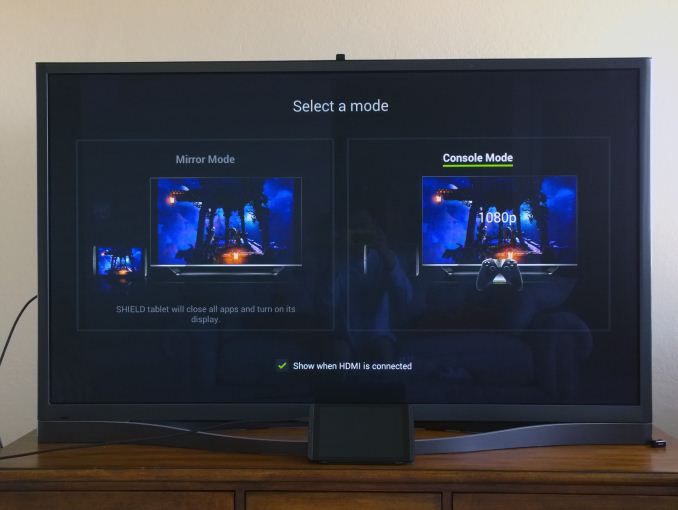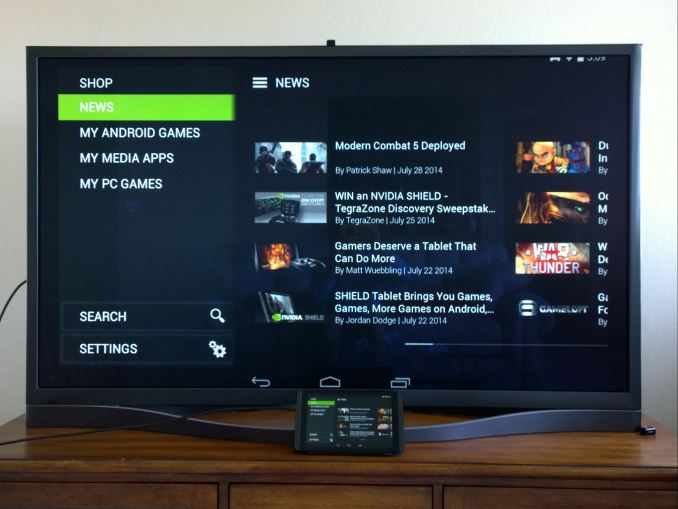The NVIDIA SHIELD Tablet Review
by Joshua Ho on July 29, 2014 9:00 AM ESTSoftware
In the UI department, there’s not too much to talk about. Much like Motorola, NVIDIA has stuck to using the AOSP UI design. Of course, there are plenty of NVIDIA-specific applications, but I didn’t run into any issues using the tablet to do everyday tasks. In this respect, things have improved massively over Shield portable. Because this tablet works in both portrait and landscape, there aren’t any issues with applications that force portrait mode like there were with the Shield portable. In normal tablet usage, it works as one might expect, with no real perceived lag throughout the UI. Of course, this is when compared to other Android devices. There are still frame drops involved in scrolling through lists and similar areas where Android has traditionally struggled to stay smooth, but Android L should fix this issue for the most part.
DirectStylus 2
The real value that the Shield tablet brings as a tablet is the stylus functionality. DirectStylus 2 is definitely much, much better than any other capacitive stylus on the market. The tip allows for precise control and it’s definitely responsive to changes in pressure. For the most part, there are only small issues here. Because the stylus is capacitive, it’s not really possible to have a floating pointer the way Wacom styluses do. In addition, I noticed that I need to lift the stylus a bit more than I might with pencil and paper in order to start a new letter or word or else my words would start to flow together. For the most part though, it works well enough, and the inking latency is low. Unfortunately the issue here is more of ecosystem than hardware, as most stylus-enabled applications aren’t nearly as robust as OneNote on Windows x86.
Console Mode
Of course, the real question here is whether the gaming side is worth the price premium. NVIDIA has gone all out on this area, and their efforts are split up into multiple aspects. The first is the TV interface/console mode, then the gameplay recording feature known as ShadowPlay. Finally, there’s the aspect of GameStream and GRID, which make it possible for games to be played on the tablet that otherwise wouldn’t work due to the compute requirements.
The TV interface effectively boils down to Shield Hub and Google Now, although it’s fully possible to use the full tablet UI as desired in this mode. In the hub, launching games and various applications like YouTube and Netflix is rather simple compared to the more cumbersome full Android UI as they have their own category in Shield Hub. In addition, launching applications through Google Now works as expected. Overall, there aren’t any friction points here. It works as well as one could expect. There is a strong reliance on voice input in general, but it’s much better than trying to type with a controller and better than most smart TV experiences. While the TV interface is mostly targeted towards enabling a console gaming experience, YouTube and Netflix both work great in this mode. NVIDIA has also gone through the necessary DRM certification process to allow for 1080p Netflix streaming. In essence, this device is already ready to serve as an Android TV device.
ShadowPlay
ShadowPlay, which we first saw in GeForce GTX GPUs, is also another major advantage that NVIDIA brings to the table for software experience. In short, this leverages the hardware H.264 video encoder that is on the Tegra K1’s Kepler GPU to provide video capture of gameplay or anything else displayed by the tablet. There are three possible options for video capture. The first is Twitch broadcasting, something that NVIDIA is quite proud of as they are the first to implement such a feature in an Android tablet. While I personally don’t stream on Twitch, a demo of Twitch broadcasting in the initial launch briefing worked without any visible quality issues in either audio or video.
There are two other recording modes. One is a standard start/stop recording feature, but the other is ShadowPlay/Auto Recording. In short, this keeps anywhere from the past minute to 20 minutes in video. This makes it possible to set and forget about the recording feature rather than constantly managing recordings in manual mode. All of these modes can use the tablet’s microphone and front facing camera for commentary purposes as needed. Local recordings seem to have a maximum of 1080p30, and Twitch broadcasts are limited to 720p30.
While those are the technical details, it’s a painless process. All the user has to do is long press the back button on the controller and select what kind of a recording they’d like to do (Twitch, Auto, Manual, Screenshot) and that’s it. I can see significant potential in this area especially if this device takes off as a gaming platform.
















174 Comments
View All Comments
surbringer - Tuesday, July 29, 2014 - link
Have you tried to run PPSSPP on it ?kyuu - Wednesday, July 30, 2014 - link
I can run PPSSPP on my Venue 8 Pro, and the K1 in this tablet is certainly much more powerful GPU-wise than Bay Trail. Shouldn't be an issue.Johnny_k - Tuesday, July 29, 2014 - link
Correction: you now can use Gamestream outside your house, (even over lte on the lte tablet version)Remotely access your PC to play your games away from your home.
http://shield.nvidia.com/play-pc-games/
Note that it is in beta
RoninX - Tuesday, July 29, 2014 - link
I'd love to see Anandtech do a real-world test on how well Gamestream works with the Shield outside the home.chizow - Tuesday, July 29, 2014 - link
Yes, unfortunate AT did not cover this at all, as I also recently found out GameStream remote was in beta. This is really the killer-app for Shield until Android gaming takes off (if it ever does). I would consider buying one of these if Remote GameStream worked decently well, but I'll probably hold off on either a Shield Portable 2 (with TK1) or a good GeForce bundle with Maxwell.ams23 - Tuesday, July 29, 2014 - link
I am impressed that Shield tablet has even higher graphics performance in GFXBench 3.0 T-Rex HD Offscreen than the actively cooled Surface Pro 2 and Surface Pro 3: http://images.anandtech.com/graphs/graph8296/65868...Note that thermal throttling behavior on Shield tablet is extremely good. There was virtually no throttling until after 115 runs (!) with the GFXBench 3.0 T-Rex HD benchmark: http://images.anandtech.com/doci/8296/TRexRunDownG...
I suspect that the 3dmark Unlimited scores are CPU-limited to some extent. Shield tablet already achieves > 200 fps on game test 1 and > 100 fps on game test 2, so this particular test is not very stressful (relatively speaking) for this GPU.
The web browsing battery life is pretty good all things considered, especially compared to iPad Mini Retina and iPad Air (which have 23% and 64% more battery capacity, respectively than Shield tablet). The Shield tablet has CPU and browser performance that is at least 2x faster than Nexus 7 2013 variant, so the web browsing efficiency is actually quite good in comparison.
UpSpin - Wednesday, July 30, 2014 - link
agreed, those results are impressive and a huge step forward, for both NVidia and all the others.Considering that the Shield uses the ancient quad core 32-bit Cortex A15 variant of the Tegra K1 and NVidia also has a custom dual core 64-bit variant of the K1 I think we can expect a further CPU boost once this 64-bit SoC reaches customers.
jospoortvliet - Thursday, July 31, 2014 - link
The A15r3 is not exactly ancient but I agree that Denver is something to look forward to 😎Anonymous Blowhard - Tuesday, July 29, 2014 - link
>Games like Saints Row 3 played as if running on a consoleSo, 720p30, Low Detail? ;)
Death666Angel - Tuesday, July 29, 2014 - link
Zing! :D